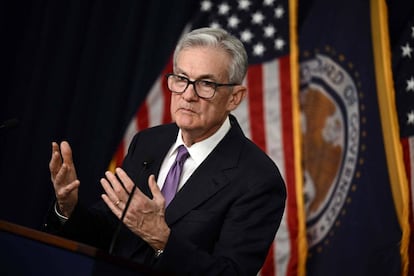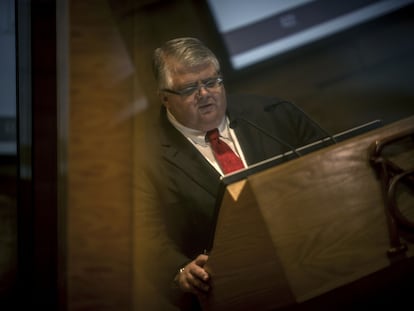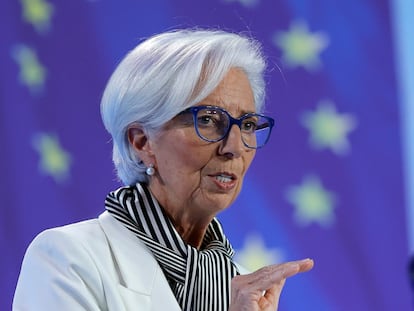The US Federal Reserve holds rates steady, but lays the groundwork for a rate cut
Fed Chair Jerome Powell calls for patience for rate cuts and effectively discards the idea that they will be lowered at the March meeting


U.S. monetary policy is at a turning point. The Federal Reserve believes it has already raised interest rates as much as it needed to control inflation. This Wednesday, it held rates at 5.25%-5.5%, the highest in almost 23 years, which the Fed has maintained since July. Now the time to lower rates is approaching. Jerome Powell, the chairman of the Federal Reserve, has begun to lay the groundwork for it, but he has also called for patience. The monetary policy committee is not confident enough that the battle against inflation has been won. “The committee does not expect that it would be appropriate to reduce the [interest rate] target range until it has gained greater confidence that inflation is moving sustainably toward 2%,” Powell has said, repeating the message of the Fed statement released shortly before.
“We believe that our policy rate is likely at its peak for this tightening cycle,” Powell explicitly conceded at the post-meeting press conference. “And that if the economy evolves as expected, it will probably be appropriate to consider lowering it sometime this year. But the economy has surprised forecasters in many ways since the pandemic and ongoing progress toward our 2% inflation objective is not assured. The economic outlook is uncertain, and we remain highly attentive to inflation risks,” he said. The Fed chairman cautioned that “we are prepared to maintain the current target range for the federal funds rate for longer if appropriate.”
The fact that the Federal Reserve believes rates will fall this year is not a secret. The committee members’ own forecasts, updated in December, pointed to a 0.75-point cut this year through the end of the year. The question is when and at what pace. Opinions were divided. The market was pricing based on the likelihood of a first rate cut in March, but after Powell’s warning on Wednesday, that possibility is fading.
Most analysts expect quarterly cuts of 0.25 points starting in the second quarter, beginning at either the May or June meeting. Powell’s message is still consistent with that scenario. In fact, at the press conference, Powell said it was “unlikely” that there will be a rate cut at the March meeting, but he did not rule out a rate cut in the first half of the year entirely.
“As labor market tightness eases and progress on inflation continues, the risks to achieving our employment and inflation objectives are moving into balance,” Powell explained. “We know that reducing monetary policy too soon or too much could result in a reversal of the progress made on inflation and ultimately require even tighter policy to bring inflation back to 2%. At the same time, reducing policy or diverting policy too late or too little could unduly weaken economic activity in employment,” he added.
“The economy has made good progress toward our dual mandate objectives,” Powell has said, referring to his goals of achieving maximum possible employment along with price stability. “Inflation has come down from its highs without a significant rise in unemployment. This is very good news,” he conceded. He then went on to emphasize that “inflation remains too high,” that “ongoing progress in reducing it is not assured,” and that “the way forward is uncertain.”
The economy grew 0.8% quarter over quarter and 3.1% year over year in the fourth quarter, showing surprising strength. For the year as a whole, gross domestic product (GDP) rose 2.5%, according to the first estimate released last Thursday by the Commerce Department’s Bureau of Economic Analysis. Meanwhile, the Fed’s preferred inflation gauge slowed to 2.9% in December, dipping below 3% for the first time since early 2021, according to data released Friday by the same agency.
When Powell was asked about whether he had achieved the economy’s soft landing, he preferred to be cautious: “Certainly, I’m encouraged and we’re encouraged by the progress,” Powell said. But “we’re not declaring victory at all at this point. We think we have a ways to go.” But whereas on other occasions he had indicated that it would be necessary to cause families and businesses “some pain” by weakening growth, his tone has changed now: “We want strong growth. We want to see a strong labor market. We don’t want a weaker labor market. We want inflation to continue to come down as it has been doing for the last six months,” he said.
In the last two years, the price of money has risen by just over five points, the most aggressive tightening of monetary policy since the 1980s, to counter the highest inflation in four decades. The central bank has not changed the rates since July of last year, but Powell has managed to keep up the pressure. He has pointed out on many occasions that, in this tightening cycle, how long rates remain high is even more important than how high the price of money goes.
A slew of Treasury bonds to be issued
On Wednesday, the U.S. Treasury updated its estimates for new debt issuance and the conclusion is that a flood of new bonds will come to market in the coming months, starting next week. The Treasury expects to place $121 billion in debt to meet the $105.1 billion of bonds coming due on February 15, so it will increase net financing by about $15.9 billion. In three auctions, on February 6, 7 and 8, the Treasury will issue three-year bonds for $54 billion, 10-year bonds for $42 billion and 30-year bonds for $25 billion.
There has also been an increase in issuance targets for the months of February, March and April. The Treasury plans to increase the size of the 2-year and 5-year auctions by $3 billion per month, the 3-year by $2 billion per month and the 7-year by $1 billion per month. As a result, the 2-, 3-, 5- and 7-year auction sizes will increase by $9 billion, $6 billion, $9 billion and $3 billion, respectively, by the end of April 2024, the Treasury announced. The United States has been increasing its debt as a result of the federal deficit, which was $1.7 trillion last fiscal year.
Sign up for our weekly newsletter to get more English-language news coverage from EL PAÍS USA Edition
Tu suscripción se está usando en otro dispositivo
¿Quieres añadir otro usuario a tu suscripción?
Si continúas leyendo en este dispositivo, no se podrá leer en el otro.
FlechaTu suscripción se está usando en otro dispositivo y solo puedes acceder a EL PAÍS desde un dispositivo a la vez.
Si quieres compartir tu cuenta, cambia tu suscripción a la modalidad Premium, así podrás añadir otro usuario. Cada uno accederá con su propia cuenta de email, lo que os permitirá personalizar vuestra experiencia en EL PAÍS.
¿Tienes una suscripción de empresa? Accede aquí para contratar más cuentas.
En el caso de no saber quién está usando tu cuenta, te recomendamos cambiar tu contraseña aquí.
Si decides continuar compartiendo tu cuenta, este mensaje se mostrará en tu dispositivo y en el de la otra persona que está usando tu cuenta de forma indefinida, afectando a tu experiencia de lectura. Puedes consultar aquí los términos y condiciones de la suscripción digital.
More information
Últimas noticias
Most viewed
- Sinaloa Cartel war is taking its toll on Los Chapitos
- Oona Chaplin: ‘I told James Cameron that I was living in a treehouse and starting a permaculture project with a friend’
- Reinhard Genzel, Nobel laureate in physics: ‘One-minute videos will never give you the truth’
- Why the price of coffee has skyrocketed: from Brazilian plantations to specialty coffee houses
- Silver prices are going crazy: This is what’s fueling the rally










































